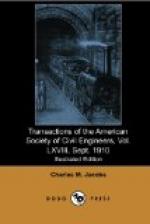Experience has shown, as was anticipated, that it is much more difficult to construct tunnels in such material as occurs in the East River and on the New Jersey side of the North River, than in more homogeneous material such as is found in the greater part of the North River. During the progress of construction under the East River, there were frequent blow-outs through fissures opened in the river-bed, and the bottom of the river over the tunnel had to be blanketed continuously with clay, to check the flow of the escaping air.
In view of the serious difficulties which it was thought might be encountered in the application of the shield method to the East River work, other methods for the execution of this part of the project received special consideration, one of the methods considered being the freezing process. It was proposed to drive a small pilot tunnel and freeze the ground for a sufficient distance around it by circulating brine through a system of pipes established in the tunnel. The pilot tunnel was then to be removed and the full-sized tunnel was to be excavated in the frozen material and its lining placed in position. By this means, it was intended to avoid the danger incident to the use of compressed air in material of greatly varying character. This method contained too many elements of uncertainty to justify its adoption; but as the Management considered it desirable to have, if possible, an alternative method, an extended experiment was made with the freezing process. A pilot tunnel, 7 ft. 6 in. in diameter, was driven in the bed of the East River for a distance of 160 ft., circulating pipes were established in it, and brine at a very low temperature was passed through the pipes until the ground was frozen for a distance of about 11.5 ft. around the tunnel. Observations to determine the rate of cooling and other important points connected with the process were carefully made. When it was found that the construction of the tunnels was progressing satisfactorily by the shield method, and that so much time was required to freeze the material that the freezing process could not be used to advantage in this particular case, the experiment was discontinued.
Design of the Sub-River Tunnels.—The sub-river tunnels consist of a circular cast-iron shell, of the segmental, bolted type, having an outside diameter of 23 ft., lined with concrete having a normal thickness of 2 ft. from the outside of the shell. Through each plate of the shell there is a small hole, closed with a screw plug, through which grout may be forced into the surrounding material. Each tunnel contains a single track. A concrete bench, the upper surface of which is 1 ft. below the axis of the tunnel, is placed on each side of the track, the distance between benches being 11 ft. 8 in. These benches contain ducts for carrying electric cables. The main reason for adopting single-track tunnels instead of a larger tunnel containing two tracks




